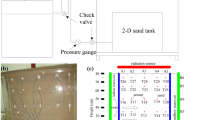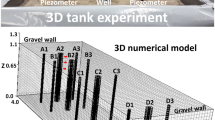Abstract
Surface water–groundwater exchange affects the material and energy transfer of rivers and adjacent riparian zones. As an intuitive carrier of energy, temperature can effectively reflect the spatial and temporal variation of surface water–groundwater exchange process. In this paper, the influence of water head variation and sand sample uniformity on its temperature field and seepage field is studied through a one-dimensional sand column laboratory test. To verify the accuracy of the one-dimensional vertical heat analysis model, the vertical seepage velocity measured in the indoor test is compared with the vertical submerged exchange rate calculated by the four analysis models. The results show that the Hatch analytical solution, Keery analytical solution, McCallum analytical solution and Luce analytical solution calculated by VFLUX2 through MATLAB are reliable for calculating the vertical undercurrent exchange rate of the heterogeneous sand column.
Similar content being viewed by others
Data availability
The data used to support the findings of this study are available from the corresponding author upon request.
References
Alexander MD, Caissie D (2003) Variability and comparison of hyporheic water temperatures and seepage fluxes in a small atlantic salmon stream. Ground Water 41(1):72–82
Anderson W, Anderson JL, Thaxton C, Babyak CM (2010) Changes in stream temperatures in response to restoration of groundwater discharge and solar heating in a culverted, urban stream. J Hydrol 393:309–320
Briggs MA, Lautz LK, McKenzie JM, Gordon RP, Hare DK (2012) Using high-resolution distributed temperature sensing to quantify spatial and temporal variability in vertical hyporheic flux. Water Resour Res 48(2):W02527
Cardenas MB (2010) Thermal skin effect of pipes in streambeds and its implications on groundwater flux estimation using diurnal temperature signals. Water Resour Res 46:W03536
Chen B (2020) Experimental study on the dynamic change characteristics of hydro-thermal in beach under water level fluctuation
Chow R, Wu H, Bennett JP, Dugge J, Wöhling T, Nowak W (2019) Sensitivity of simulated hyporheic exchange to river bathymetry: the steinlach river test site. Ground Water 57:378–391
Conant B (2004) Delineating and quantifying ground water discharge zones using streambed temperatures. Ground Water 42(2):243–257
Dun Y, Tang C, Shen Y (2014) Identifying interactions between river water and groundwater in the North China Plain using multiple tracers. Environ Earth 72:99–110
Edwardson KJ, Bowden WB, Dahm CN, Morrice JA (2003) The hydraulic characteristics and geochemistry of hyporheic and parafluvial zones in Arctic tundra streams, north slope, Alaska. Adv Water Resour 26:907–923
Engelhardt I, Piepenbrink M, Trauth N, Stadler S, Kludt C, Schulz M, Schüth C, Ternes TA (2011) Comparison of tracer methods to quantify hydrodynamic exchange within the hyporheic zone. J Hydrol 400:255–266
Engelhardt I, Prommer H, Moore CR, Schulz M, Schüth C, Ternes TA (2013) Suitability of temperature, hydraulic heads, and acesulfame to quantify wastewater-related fluxes in the hyporheic and riparian zone. Water Resour Res 49(1):426–440
Fanelli RM, Lautz LK (2008) Patterns of water, heat, and solute flux through streambeds around small dams. Ground Water 46:671–687
Fritz B, Arntzen EV (2007) Effect of rapidly changing river stage on uranium flux through the hyporheic zone. Ground Water 45:753–760
Gordon RP, Lautz LK, Briggs MA, McKenzie JM (2012) Automated calculation of vertical pore-water flux from field temperature time series using the VFLUX method and computer program. J Hydrol 420:142–158
Halloran LJ, Roshan H, Rau GC, Andersen MS, Acworth RI (2016) Improved spatial delineation of streambed properties and water fluxes using distributed temperature sensing. Hydrol Process 30:2686–2702
Harvey JW, Böhlke JK, Voytek MA, Scott DT, Tobias CR (2013) Hyporheic zone denitrification: controls on effective reaction depth and contribution to whole-stream mass balance. Water Resour Res 49:6298–6316
Hatch CE, Fisher AT, Revenaugh J, Constantz JE, Ruehl CR (2006) Quantifying surface water–groundwater interactions using time series analysis of streambed thermal records: method development. Water Resour Res 42:W10410
Hayashi M, Rosenberry DO (2002) Effects of ground water exchange on the hydrology and ecology of surface water. Ground Water 40:309–316
Irvine DJ, Lautz LK, Briggs MA, Gordon RP, McKenzie JM (2015) Experimental evaluation of the applicability of phase, amplitude, and combined methods to determine water flux and thermal diffusivity from temperature time series using VFLUX 2. J Hydrol 531(3):728–737
Ji Y, Shi W, Chen Q, An L (2018) Calculation method of temperature tracing velocity in the hyporheic zone of the reservoir continent beach. J Water Resourc Water Eng 03:159–163
Kalbus E, Reinstorf F, Schirmer M (2006) Measuring methods for groundwater—surface water interactions: a review. Hydrol Earth Syst Sci 10:873–887
Kanduč T, Grassa F, McIntosh J, Stibilj V, Ulrija-Supovec M, Supovec L, Jamnikar S (2014) A geochemical and stable isotope investigation of groundwater/surface-water interactions in the Velenje Basin, Slovenia. Hydrogeol J 22:971–984
Kasahara T, Hill AR (2006) Hyporheic exchange flows induced by constructed riffles and steps in lowland streams in southern Ontario Canada. Hydrol Process 20(20):4287–4305
Keery J, Binley A, Crook NP, Smith JW (2007) Temporal and spatial variability of groundwater–surface water fluxes: development and application of an analytical method using temperature time series. J Hydrol 336:1–16
Kiel B, Bayani Cardenas M (2014) Lateral hyporheic exchange throughout the Mississippi River network. Nat Geo 7:413–417
Lane CR, Leibowitz SG, Autrey BC, LeDuc SD, Alexander LC (2018) Hydrological, physical, and chemical functions and connectivity of non-floodplain wetlands to downstream waters: a review. J Am Water Resourc Assoc (JAWRA) 54(2):346–371
Lautz LK (2010) Impacts of nonideal field conditions on vertical water velocity estimates from streambed temperature time series. Water Resources Research 46:W01509
Lautz LK (2012) Heat tracing of temporal changes in vertical flux through streambed sediments. Geol Soc Am Abst Prog 44(7):50
Lautz LK, Kranes N, Siegel DI (2010) Heat tracing of heterogeneous hyporheic exchange adjacent to in-stream geomorphic features. Hydrol Process 24(21):3074–3086
Li Y, Zhao J, Lv H, Chen B (2016) Investigation on temperature tracer method calculated flow rate of hyporheic layer in riparian zone. Adv Water Sci 03:423–429
Liu D, Zhao J, Lv H (2017) Comparative analysis of water-heat exchange characteristics of the riparian zone downstream of dam in different seasons. Adv Water Sci 01:124–132
Lu C, Chen S, Jiang Y, Shi J, Yao C, Su X (2018) Quantitative analysis of riverbank groundwater flow for the Qinhuai River, China, and its influence factors. Hydrol Process 32:2734–2747
Lu C, Ji K, Zhang Y, Jan HF, Zheng C, Kate S (2020) Event-driven hyporheic exchange during single and seasonal rainfall in a gaining stream. Water Resour Manag 34:1–15
Luce CH, Tonina D, Gariglio F, Applebee R (2013) Solutions for the diurnally forced advection-diffusion equation to estimate bulk fluid velocity and diffusivity in streambeds from temperature time series. Water Resour Res 49(1):488–506
McCallum AM, Andersen MS, Rau GC, Acworth RI (2012) A 1-D analytical method for estimating surface water–groundwater interactions and effective thermal diffusivity using temperature time series. Water Resour Res 48(11):W11532
Qureshi ME, Harrison SR (2001) A decision support process to compare riparian revegetation options in Scheu Creek catchment in north Queensland. J Environ Manag 62(1):101–102
Rau GC, Andersen MS, Acworth RI (2012) Experimental investigation of the thermal dispersivity term and its significance in the heat transport equation for flow in sediments. Water Resour Res 48:W03511
Rosenberry DO, Pitlick J (2009) Effects of sediment transport and seepage direction on hydraulic properties at the sediment-water interface of hyporheic settings. J Hydrol 373:377–391
Schmidt C, Bayer-Raich M, Schirmer M (2006) Characterization of spatial heterogeneity of groundwater-stream water interactions using multiple depth streambed temperature measurements at the reach scale. Hydrol Earth Syst Sci 10:849–859
Shanafield M, Hatch CE, Pohll G (2011) Uncertainty in thermal time series analysis estimates of streambed water flux. Water Resour Res 47:W03504
Song J, Cheng D, Zhang J, Zhang Y, Long Y, Zhang Y, Shen W (2019) Estimating spatial pattern of hyporheic water exchange in slack water pool. J Geog Sci 29:377–388
Stallman RW (1963) Computation of ground-water velocity from temperature data.
Stallman RW (1965) Steady one-dimensional fluid flow in a semi-infinite porous medium with sinusoidal surface temperature. J Geophys Res 70:2821–2827
Swanson TE, Cardenas MB (2010) Diel heat transport within the hyporheic zone of a pool-riffle-pool sequence of a losing stream and evaluation of models for fluid flux estimation using heat. Limnol Oceanogr 55(4):1741–1754
Swanson TE, Cardenas MB (2011) Ex-Stream: a MATLAB program for calculating fluid flux through sediment-water interfaces based on steady and transient temperature profiles. Comput Geosci 37:1664–1669
Swanson SR, Kozlowski DF, Hall RK, Heggem DT, Lin J (2017) Riparian proper functioning condition assessment to improve watershed management for water quality. J Soil Water Conserv 72:168–182
Taniguchi M, Burnett WC, Smith CF, Paulsen RJ, O’Rourke D, Krupa SL, Christoff JL (2003) Spatial and temporal distributions of submarine groundwater discharge rates obtained from various types of seepage meters at a site in the Northeastern Gulf of Mexico. Biogeochemistry 66:35–53
Trauth N, Schmidt C, Maier U, Vieweg M, Fleckenstein JH (2013) Coupled 3-D stream flow and hyporheic flow model under varying stream and ambient groundwater flow conditions in a pool-riffle system. Water Resour Res 49:5834–5850
Vogt T, Schneider P, Hahn-Woernle L, Cirpka OA (2010) Estimation of seepage rates in a losing stream by means of fiber-optic high-resolution vertical temperature profiling. J Hydrol 380:154–164
Vogt T, Schirmer M, Cirpka OA (2012) Investigating riparian groundwater flow close to a losing river using diurnal temperature oscillations at high vertical resolution. Hydrol Earth Syst 16:473–487
Wilding TK, Sanderson JS, Merritt DM, Rood SB, Poff NL (2014) Riparian responses to reduced flood flows: comparing and contrasting narrowleaf and broadleaf cottonwoods. Hydrological Sciences Journal 59:605–617
Wondzell SM, Swanson FJ (1996) Seasonal and storm dynamics of the hyporheic zone of a 4th-order mountain stream. II: nitrogen cycling. J N Am Benthol Soc 15:20–34
Zhu S, Shu C, Lu P (2013) Study on the heterogeneity of vertical hyporheic flux using a heat tracing method. J Hydraul Eng 07:818–825
Funding
This work was supported by the Program 2022TD-01 for Shaanxi Provincial Innovative Research Team and the Key Scientific Research Project of the Education Department of Shaanxi Province (Grant No. 20JS102) and Supported by the Open Research Fund Program of State Key Laboratory of Eco-hydraulics in Northwest Arid Region, Xi’an University of Technology (Grant No. 2021KFKT-3), and Supported by Open Research Fund Program of State Key Laboratory of Hydraulics and Mountain River Engineering Sichuan University (Grant No. SKHL2106).
Author information
Authors and Affiliations
Contributions
Jie Ren, Jinjin Zhang and Dabo Wang wrote the main manuscript text and Jinjin Zhang prepared figures 1-2 and Dabo Wang prepared figures 3-6. Jie Ren reviewed the manuscript.
Corresponding author
Ethics declarations
Conflict of interest
The authors declare that are no conflict of interest.
Additional information
Publisher's Note
Springer Nature remains neutral with regard to jurisdictional claims in published maps and institutional affiliations.
Rights and permissions
Springer Nature or its licensor (e.g. a society or other partner) holds exclusive rights to this article under a publishing agreement with the author(s) or other rightsholder(s); author self-archiving of the accepted manuscript version of this article is solely governed by the terms of such publishing agreement and applicable law.
About this article
Cite this article
Ren, J., Zhang, J. & Wang, D. Validation of an analytical model of groundwater velocity based on laboratory test and numerical simulation. Environ Earth Sci 82, 258 (2023). https://doi.org/10.1007/s12665-023-10959-3
Received:
Accepted:
Published:
DOI: https://doi.org/10.1007/s12665-023-10959-3










